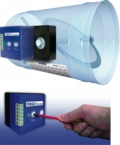Energy-efficient upgrading of VAV systems cuts carbon emissions

Sustainable refurbishment of VAV — Michael Wild
Retrofitting a modern approach to controlling airflow in VAV systems has enormous energy-saving potential, according to Michael Wild.VAV air conditioning (variable air volume) was once one of the most popular systems and dates back to the mid-1970s. At its peak the UK market was around 80 000 VAV boxes. In recent years its popularity has reduced in favour of air-water systems, particularly multi-service chilled beams. There are still applications for VAV with variable cooling loads, such as meeting rooms and the specialist process air-conditioning market — for example pharmaceuticals and laboratories.
Significant energy saving It is estimated that there are over a million VAV boxes still operating, mainly in comfort air-conditioning applications in offices Some of the original VAV boxes had what was known as a ‘mechanical damper’, which incorporated springs and weights so that a range of pre-set air volumes could be controlled irrespective of changes in downstream duct pressure. These dampers required quite a high static pressure to get the actions of the springs and damper mechanism operational; typically 200 Pa was required. Today’s VAV boxes and valves require very much lower pressures to operate them. 20 Pa is typical, which would show a significant energy saving over the original units. This 180 Pa in operating pressure related to a building of, say, 40 000 m2 with an airflow of 15 l/s/m2 would achieve a reduction in energy consumption of 308 000 kWh a year, amounting to a staggering 132 440 kg reduction in carbon-dioxide emissions. This reduction in carbon-dioxide emissions in itself should motivate the client to survey and refurbish his VAV system. The accuracy with which these original VAV boxes can control the air flow depends very much on the life of the springs and other mechanisms. Generally speaking, VAV units which are in continuous operation would have a useful working life of 15 to 20 years. During the life of the unit, regular maintenance and monitoring should take place to ensure that they operate effectively. Even with this maintenance there is a risk that operational difficulties will be found within the VAV unit, which could lead to much wider variations in supply-air volumes as the box drifts away from its normal tolerances, leading to much wider fluctuations in temperature because the room at times could be over heated or over cooled. These fluctuations pose significant energy issues since the VAV box is not effectively controlling the environment, and energy consumption and associated carbon-dioxide emissions will be higher.
 |
By requiring only a tenth of the pressure to operate them compared with older-style dampers in VAV boxes, replacement modern dampers can achieve huge savings in energy consumption and carbon-dioxide emissions. The control box provides for easy setting of air volume and can communicate with a BMS. |
Another important part of the VAV box is the sensor placed in the duct to measure airflow. It has been found that sensors mounted in the duct in the airstream can, with time, be affected by build up of dust, which can also have a detrimental effect on the energy efficiency of the VAV box. Modern sensors are like a grid sampling air and passing it through sensitive electronic parts, which are now mounted externally as part of the controller instead of being in the ducting. Since most of these older-style units run inefficiently, there is an enormous potential for energy saving if new units are installed. Replacing units can be a costly business because everything in the ceiling and above needs to be stripped out. However, if the refurbishment could be simplified to reduce costs and disruption, many VAV buildings may be encouraged to go down the refurbishment route. There is also a strong sustainability argument in favour of extending the life of a VAV system, particularly if there is a way to improve the efficiency of the VAV unit by an effective but simple upgrade. There is now an initial and growing demand for a complete refurbishment of these old VAV boxes, and a single point responsibility seems to be preferred. Trox offers site surveys and validation of VAV units, together with a comprehensive installation and maintenance package. Refurbishing VAV boxes can be a relatively simple task when using a modern VAV valve with a low lift-off pressure of 20 Pa and incorporate a controller that can communicate with the BMS if required. The actual refurbishment is purely a matter of disabling the old damper or removing the old damper section. The new valve is then fixed to the inlet of the VAV box and the controller wired into the existing or modified circuit. All the static parts of the VAV box are retained, subject to inspection. It may be necessary to replace attenuator sections if damaged. Where boxes can be upgraded in this way, it is usually possible to retain the ducting, thus minimising the refurbishment costs and potential disruption. These VAV valves are suitable for all makes of VAV boxes and offer an effective solution to VAV refurbishment.
Michael Wild is with the service division of Trox UK.
Related links:










